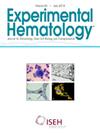Ever-evolving insights into the cellular and molecular drivers of lymphoid cell development
IF 2.5
4区 医学
Q2 HEMATOLOGY
引用次数: 0
Abstract
Lymphocytes play a critical role in adaptive immunity and defense mechanisms, but the molecular mechanisms by which hematopoietic stem and progenitor cells differentiate into T and B lymphocytes are not fully established. Pioneer studies identify several transcription factors essential for lymphoid lineage determination. Yet, many questions remain unanswered about how these transcription factors interact with each other and with chromatin at different developmental stages. This interaction regulates a network of genes and proteins, promoting lymphoid lineage differentiation while suppressing other lineages. Throughout this intricate biological process, any genetic or epigenetic interruptions can derail normal differentiation trajectories, potentially leading to various human pathologic conditions. Here, we summarize recent advances in understanding lymphoid cell development, which was the focus of the Winter 2024 International Society for Experimental Hematology webinar.
对淋巴细胞发育的细胞和分子驱动因素的认识不断发展。
淋巴细胞在适应性免疫和防御机制中发挥着关键作用,但造血干细胞和祖细胞分化成 T 淋巴细胞和 B 淋巴细胞的分子机制尚未完全确定。先驱研究发现了几种对淋巴细胞系决定至关重要的转录因子。然而,关于这些转录因子在不同发育阶段如何相互影响以及如何与染色质相互作用,许多问题仍未得到解答。这种相互作用调节着基因和蛋白质网络,在促进淋巴系分化的同时抑制其他系的分化。在这一错综复杂的生物过程中,任何遗传或表观遗传干扰都可能破坏正常的分化轨迹,从而可能导致各种人类病症。在此,我们总结了了解淋巴细胞发育的最新进展,这也是 2024 年冬季国际实验血液学会网络研讨会的重点。
本文章由计算机程序翻译,如有差异,请以英文原文为准。
求助全文
约1分钟内获得全文
求助全文
来源期刊

Experimental hematology
医学-血液学
CiteScore
5.30
自引率
0.00%
发文量
84
审稿时长
58 days
期刊介绍:
Experimental Hematology publishes new findings, methodologies, reviews and perspectives in all areas of hematology and immune cell formation on a monthly basis that may include Special Issues on particular topics of current interest. The overall goal is to report new insights into how normal blood cells are produced, how their production is normally regulated, mechanisms that contribute to hematological diseases and new approaches to their treatment. Specific topics may include relevant developmental and aging processes, stem cell biology, analyses of intrinsic and extrinsic regulatory mechanisms, in vitro behavior of primary cells, clonal tracking, molecular and omics analyses, metabolism, epigenetics, bioengineering approaches, studies in model organisms, novel clinical observations, transplantation biology and new therapeutic avenues.
 求助内容:
求助内容: 应助结果提醒方式:
应助结果提醒方式:


